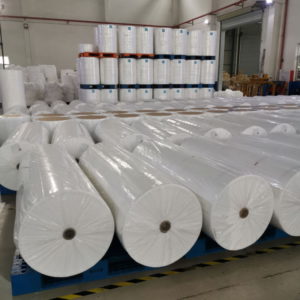When choosing a PP spunmelt machine for manufacturing PP spunbond fabric, several factors should be taken into consideration. These factors include:
Production Capacity: Determine the desired production capacity in terms of fabric weight per unit area (gsm) or fabric width (meters). This will help in selecting a machine that can meet the required output. Consider factors such as machine speed, width, and efficiency to ensure it aligns with your production goals.
Machine Configuration: There are different configurations available for PP spunmelt machines, including single-beam, double-beam, and multi-beam configurations. Each configuration has its advantages and is suitable for specific production requirements. Evaluate the desired fabric characteristics, such as weight, structure, and performance, to choose the most appropriate machine configuration.
Fabric Properties: Consider the desired properties of the PP spunbond fabric, such as strength, elongation, barrier properties, and breathability. Different machine designs and process parameters can influence these properties. Consult with machine manufacturers to ensure the machine can produce the desired fabric properties.
Raw Material Compatibility: PP spunmelt machines are designed for processing polypropylene (PP) as the main raw material. However, it is important to consider the compatibility with specific grades of PP resin, including virgin PP, recycled PP, or specialty PP. Verify that the machine can handle the desired raw material and any additives required for specific fabric functionalities.
Energy Efficiency: Energy consumption is a significant consideration for manufacturing operations. Evaluate the energy efficiency of the machine, including power consumption, heating methods, and overall energy-saving features. Look for machines that optimize energy usage without compromising production quality.
Maintenance and Service: Consider the availability of technical support, spare parts, and maintenance services offered by the machine manufacturer. A reliable support system ensures prompt assistance and minimizes downtime in case of any issues or maintenance requirements.
Cost and Return on Investment (ROI): Assess the overall cost of the machine, including initial investment, installation, training, and ongoing operational expenses. Compare the cost with the projected production output and potential market demand to determine the return on investment. Consider the long-term reliability and durability of the machine to ensure its cost-effectiveness.
Regulatory Compliance: Ensure that the machine complies with relevant safety and regulatory standards, both in terms of machinery safety and the quality of the produced fabric. Compliance with standards such as ISO, CE, and relevant industry-specific certifications is crucial.
Manufacturer Reputation: Research the reputation, PP S Spunbond Machine experience, and track record of the machine manufacturer. Consider their expertise in PP spunmelt technology, customer reviews, and references from other users. A reputable manufacturer with a proven track record can provide reliable machinery and after-sales support.
By carefully considering these factors, you can select a PP spunmelt machine that aligns with your production requirements, fabric properties, efficiency goals, and long-term business objectives.
Are there any environmental considerations associated with using a PP Spunmelt Machine?
Yes, there are environmental considerations associated with using a PP spunmelt machine for manufacturing PP spunbond fabric.
Here are some key environmental factors to consider:
Energy Consumption: PP spunmelt machines require energy for various operations, including heating, extrusion, and machine movement. High energy consumption can contribute to greenhouse gas emissions and environmental impact. When choosing a machine, consider energy-efficient models that optimize energy usage and reduce carbon footprint. Look for features such as energy-saving modes, efficient heating systems, and advanced control systems that minimize energy waste.
Raw Material Usage: PP spunmelt machines use polypropylene (PP) resin as the primary raw material. The production of PP resin involves extracting and processing fossil fuels. Consider the environmental impact associated with the extraction and production of PP resin, as well as the use of virgin or recycled PP resin. Using recycled PP resin can help reduce the demand for new raw material extraction and lower the carbon footprint.
Waste Generation and Management: PP spunmelt machines generate waste during the production process, such as trimmings, offcuts, and rejected fabric. Efficient waste management practices, such as recycling, reusing, or repurposing the waste materials, can minimize the environmental impact. Consider implementing waste reduction strategies and working with recycling facilities to handle and recycle the generated waste effectively.
Emissions and Air Quality: PP spunmelt machines may emit certain pollutants and volatile organic compounds (VOCs) during operation, particularly during the heating and curing processes. These emissions can contribute to air pollution and impact air quality. Ensure that the machine meets relevant emission standards and consider implementing emission control measures such as air filtration systems or emission treatment technologies.
Water Usage: While PP spunmelt machines do not typically consume large amounts of water during the manufacturing process, there may be water usage associated with cooling systems or cleaning processes. Implement water conservation practices and consider using water-efficient technologies to minimize water consumption and wastewater generation.
Compliance with Environmental Standards: Ensure that the PP spunmelt machine and the manufactured fabric comply with relevant environmental regulations and standards. These may include emissions standards, waste management regulations, and hazardous substance restrictions. Compliance with standards such as ISO 14001 (environmental management systems) and Oeko-Tex certification can demonstrate a commitment to environmental sustainability.
Product Lifecycle: Consider the environmental impact of the PP spunbond fabric throughout its lifecycle, including its use, disposal, and potential for recycling or reuse. Design the fabric with end-of-life considerations in mind, such as recyclability or biodegradability, to minimize environmental impact.
By considering these environmental factors and implementing sustainable practices, such as energy efficiency, waste reduction, and responsible raw material sourcing, the environmental impact of using a PP spunmelt machine can be minimized.
